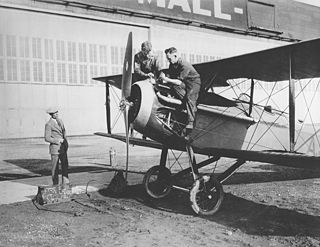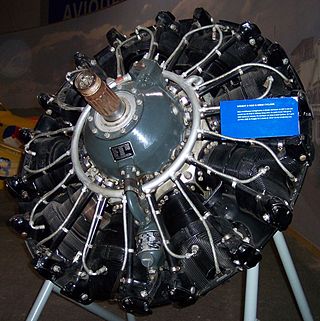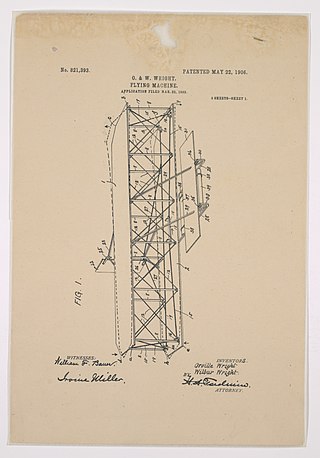
The Lockheed Corporation was an American aerospace manufacturer. Lockheed was founded in 1926 and later merged with Martin Marietta to form Lockheed Martin in 1995. Its founder, Allan Lockheed, had earlier founded the similarly named but otherwise-unrelated Loughead Aircraft Manufacturing Company, which was operational from 1912 to 1920.

Aerospace is a term used to collectively refer to the atmosphere and outer space. Aerospace activity is very diverse, with a multitude of commercial, industrial and military applications. Aerospace engineering consists of aeronautics and astronautics. Aerospace organizations research, design, manufacture, operate, or maintain both aircraft and spacecraft.

The Glenn L. Martin Company—also known as The Martin Company from 1957-1961—was an American aircraft and aerospace manufacturing company founded by aviation pioneer Glenn L. Martin, and operated between 1917-1961. The Martin Company produced many important aircraft for the defense of the US and allies, especially during World War II and the Cold War. During the 1950s and 60s, the Martin Company moved from the aircraft industry into the guided missile, space exploration, and space utilization industries.

The Bell Aircraft Corporation was an American aircraft manufacturer, a builder of several types of fighter aircraft for World War II but most famous for the Bell X-1, the first supersonic aircraft, and for the development and production of many important civilian and military helicopters. Bell also developed the Reaction Control System for the Mercury Spacecraft, North American X-15, and Bell Rocket Belt. The company was purchased in 1960 by Textron, and lives on as Bell Textron.
The Curtiss-Wright Corporation is a manufacturer and services provider headquartered in Parsippany-Troy Hills, New Jersey, with factories and operations in and outside the United States. Created in 1929 from the consolidation of Curtiss, Wright, and various supplier companies, the company was immediately the country's largest aviation firm and built more than 142,000 aircraft for the U.S. military during World War II. Today, it no longer makes aircraft but makes many related components, particularly actuators, aircraft controls, valves, and surface-treatment services. It also supplies the commercial, industrial, defense, and energy markets; it makes parts for commercial and naval nuclear power systems, industrial vehicles, and oil- and gas-related machinery.

Glenn Hammond Curtiss was an American aviation and motorcycling pioneer, and a founder of the U.S. aircraft industry. He began his career as a bicycle racer and builder before moving on to motorcycles. As early as 1904, he began to manufacture engines for airships. In 1908, Curtiss joined the Aerial Experiment Association, a pioneering research group, founded by Alexander Graham Bell at Beinn Bhreagh, Nova Scotia, to build flying machines.

Curtiss Aeroplane and Motor Company was an American aircraft manufacturer originally founded by Glenn Hammond Curtiss and Augustus Moore Herring in Hammondsport, New York. After significant commercial success in its first decades, it merged with the Wright Aeronautical to form Curtiss-Wright Corporation.

Wright Aeronautical (1919–1929) was an American aircraft manufacturer headquartered in Paterson, New Jersey. It was the successor corporation to Wright-Martin. It built aircraft and was a supplier of aircraft engines to other builders in the golden age of aviation. Wright engines were used by Amelia Earhart and Charles Lindbergh. In 1929, the company merged with Curtiss Aeroplane and Motor Corporation to form Curtiss-Wright.

The Robert J. Collier Trophy is an annual aviation award administered by the U.S. National Aeronautic Association (NAA), presented to those who have made "the greatest achievement in aeronautics or astronautics in America, with respect to improving the performance, efficiency, and safety of air or space vehicles, the value of which has been thoroughly demonstrated by actual use during the preceding year."

Donald Wills Douglas Sr. was an American aircraft industrialist and engineer.

Vought was the name of several related American aerospace firms. These have included, in the past, Lewis and Vought Corporation, Chance Vought, Vought-Sikorsky, LTV Aerospace, Vought Aircraft Companies, and Vought Aircraft Industries.

Wright Cyclone was the name given to a family of air-cooled radial piston engines designed by the Wright Aeronautical Corporation and used in numerous American aircraft in the 1930s and 1940s.

Frederick Brant Rentschler was an American aircraft engine designer, aviation engineer, industrialist, and the founder of Pratt & Whitney Aircraft. Rentschler created and manufactured many revolutionary aircraft engines, including those used in the aircraft of Charles Lindbergh, Amelia Earhart and James Doolittle. He is also a co-founder of United Aircraft and Transport Corporation, the predecessor of United Technologies Corporation.

The Burgess Company was a U.S. airplane manufacturer between 1910 and 1918.

The Wright brothers patent war centers on the patent they received for their method of airplane flight control. The Wright brothers were two Americans who are widely credited with inventing and building the world's first flyable airplane and making the first controlled, powered and sustained heavier-than-air human flight on December 17, 1903.
The Manufacturer's Aircraft Association (MAA) was a trade association and patent pool of U.S. aircraft manufacturers formed in 1917.
The Grinnell Aeroplane Company was an American aircraft manufacturer based in Grinnell, Iowa, that built aircraft prior to World War I.

The Glenn L. Martin Maryland Aviation Museum is located at Martin State Airport in Middle River, Maryland. It educates visitors through the use of exhibits, artifacts, archival materials and stories about aviation in Maryland over the last hundred years, with an emphasis on the Glenn L. Martin Company and the more recent Lockheed Martin histories.

Frank Henry Russell was an American aviation pioneer and the first General Manager of the Wright Brothers Company at Dayton, Ohio. He went on to co-found the Burgess Company and the Manufacturers Aircraft Association. He was the Vice President and a director of Curtiss Aeroplane & Motor Company and a director of Curtiss-Wright Corporation.


















